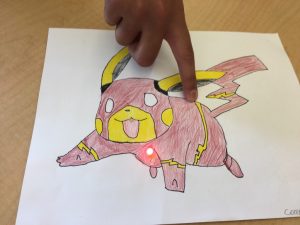During this week’s activities, I investigated how information visualization tools would add to students knowledge of simple circuits. Information Visualization Tools allow students to engage and interact with technology to further their math or science knowledge and understanding. They also allow the invisible to become visible. One common area where misconceptions occur in science is with simple and parallel circuits (Brna, 1988). Many students have difficulty taking their knowledge of circuits from linear worksheet diagrams into system and simultaneous projects. To address these misconceptions, I have combined the Info-Vis PhET for simple circuits along with a tangible paper circuit lesson plan. Finkelstein, Adams, Keller, Kohl, Perkins, Podolefsky and Reid (2005) found that students were very successful transferring simulated circuits to real-life situations. PhET is a “research-based interactive computer simulation” (University of Colorado, 2017) for teaching and learning math and science and to have students engage with the content. The lesson I have created not only ties into the new B.C. Science 7 curriculum, while also addressing the design thinking component of the new Applied Design, Skills & Technologies (ADST) giving students the opportunity for hands on – minds on learning.




Goals:
- Students will be able to demonstrate basic knowledge of simple circuits and parallel circuits.
- Students will have an opportunity to use their knowledge of simple and parallel circuits in the creation of a paper circuit card
Materials:
- Computers with PhET Simple Circuit Construction Simulation – https://phet.colorado.edu/en/simulation/circuit-construction-kit-dc
- Paper Circuit Materials: Cardstock, 3mm or 5mm LED lights, 3v coin cell battery, paper clip, copper tape, other paper materials as needed (coloured paper, tissue paper, recyclables, etc.)
STEM Activity – 5 Steps
Step 1 – Teacher will access prior knowledge by reviewing simple and parallel circuits and address any misconceptions that arise. This could be done using a tool such as Kahoot for added student engagement.
Step 2 – Generate – In small groups, students will generate a hypothesis about simple or parallel circuits and the flow of electrons through the circuit. The teacher will circulate and engage in conversations with students and have them articulate their thinking.
Step 3 – Evaluate – Students will evaluate their hypothesis using the PhET simulation and share out their findings. The PhET simulation allows students to visualize the flow of electrons through the circuit. This is a very different cognitive experience than just seeing a “light turn on”. What did students notice using the simulation? Students should reflect on using the simulation.
Step 4 – Modify – Based on their experiences with the PhET simulation, students will modify their thinking. The teacher will provide a brief overview of the paper circuit task. They will begin to outline their construction of their paper circuit using the information gained from the simulation. Transferring the knowledge from the simulation to the real-world application (the paper circuit) card and go back through T-GEM cycle using real-world circuit. Students will test out their circuit and attempt to make changes if the circuit does not work. Students will reflect on their learning.
Step 5 – Extend – The teacher will challenge students to extend their knowledge by adding a switch to their circuit. What did they notice? What did they need to know about electrons and circuits to make the switch work successfully?
Reflections On This Emerging Genre
Information Visualization software can literally make the invisible visible. For many students troubled by misconceptions in math or science, this opportunity for visualization of concepts can help to address and alleviate some of the challenges. This is particularly true for concepts that are abstract. However, students will need to be educated on how to use the different software, as on first glance I found them quite confusing! This was the first time I had really used the PhET software and found it much easier to use than NetLogo. I have previously used Gizmos from Explore Learning in my math and science classes and found this program particularly user friendly with my middle school students. The lessons were also scaffolded appropriately and students have a mix of visual cues and text to support their learning. From my experience, students felt confident in understanding the material as they had had the opportunity to manipulate the “objects” and really see the underlying principles at work. One drawback with Gizmos are that it costs the school so this can be limiting. However, software such as PhET is free for schools to use.
References
B.C. Science 7 Curriculum (2017). Retrieved from https://curriculum.gov.bc.ca/curriculum/science/7
Brna, P. (1988). Confronting misconceptions in the domain of simple electrical circuits. Instructional Science, 17(1), 29-55.
Finkelstein, N.D., Perkins, K.K., Adams, W., Kohl, P., & Podolefsky, N. (2005). When learning about the real world is better done virtually: A study of substituting computer simulations for laboratory equipment. Physics Education Research,1(1), 1-8. Retrieved from https://journals-aps-org.ezproxy.library.ubc.ca/prper/abstract/10.1103/PhysRevSTPER.1.010103
University of Colorado (2017). About PhET. Retrieved from https://phet.colorado.edu/en/about August 8,2017.